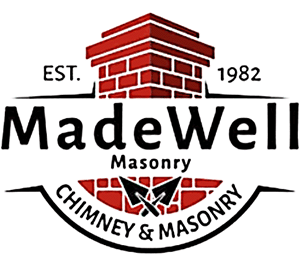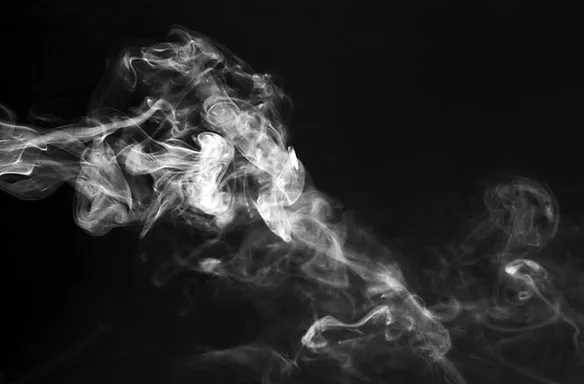Fireplaces work because hot air rises. When you start a fire, the air inside the chimney becomes warmer and less dense than the air outside the chimney, and so it starts to rise. As the warm air rises, cooler air from the room flows into the unit, fanning the fire, creating more heat in an ongoing cycle. There are also some pressure differentials produced as wind moves across the top of your chimney.
Listed below are some of the basics, starting with the more obvious solutions and working towards the more challenging. Please keep in mind this is a simplified list. A true understanding of fireplaces requires extensive knowledge of air flow patterns, pressure differentials, and fireplace construction techniques. If this information does not help you solve the problem with your fireplace, consider calling us, MadeWell Masonry, and we can almost always solve your problem.
1) Is your damper fully open?
Everybody eventually forgets to open the damper. Many dampers are unable to operate due to water damage or soot buildup behind them on the smoke shelf. Professional servicing can usually solve this problem.
2) Is your firewood green or wet from rain or snow?
Remember the main reason your fireplace works at all is the heat inside the chimney. If your wood is not well-seasoned it will produce more smoke than heat. To identify well seasoned wood, check the ends of the logs. If they are dark in color and cracked, they are dry. Dry seasoned wood is lighter in weight than wet wood and makes a hollow sound when hitting two pieces together. If there is any green color visible or bark is hard to peel, the log is not yet dry.
3) Is your chimney dirty?
The gradual accumulation of soot can affect the way your chimney performs. Thick layers of soot can restrict the flue and as little as a 1/4″ to 1/2″ inch buildup can make more difference than you might think. Consider that a 1/2″ buildup will restrict the air flow by 17% for a typical masonry fireplace chimney, and by a whopping 30% for the average prefabricated fireplace. Birds and small animals also think your chimney looks like a hollow tree in which to set up housekeeping. Sweeps often find chimneys packed full of leaves, twigs and baby animals. The solution of course is a good cleaning and a chimney cap.
4) Is your chimney tall enough?
To function properly, the chimney should be at least 10 or 12 feet in height. Where it projects above the roof, the chimney should be at least 3 feet tall, and at least 2 feet higher than anything within 10 feet of it, including other buildings, trees, etc. If your fireplace smokes worse when the wind blows it’s likely because your chimney is too short.
5) Is your flue large enough for the fireplace opening?
There are many variables that can affect this including; chimney height, how warm the flue stays, throat configuration, etc., but the basic rule of thumb is that the area of the fireplace opening can be no more than 10 times the area of the flue (12 times for round flues). An undersized flue can’t handle the volume of smoke produced, and some of it will spill back into the room. Since there is no practical way to make the flue size larger, the solution may be to make the room opening smaller with metal smoke guards or some creative masonry work. In fact there are now some pre-manufactured refractory firebox retrofits that work well with a 15 to 1 ratio and deliver twice the heat of conventional fireboxes.
6) Is your chimney on the outside of the house?
Remember that warm rising air is the basic engine involved here. If you have a large masonry chimney on the outside of the house, and it’s cold outside, the air inside of the chimney will also be very cold, causing it to fall down the chimney instead of rising. This can even happen a day or two after it’s warmed up outside. These chimneys may be hard to start and they may smoke as the fire burns low. To help get the fire started many people light some rolled up newspaper and hold it up near the damper to get the air moving upwards. Keeping a moderate sized but bright, actively flaming fire can also help this situation. Remember that as the fire dies down, it will revert back to the original direction of flow.
7) Is your home too tight?
Fireplaces need large volumes of air to burn. Visualize a 12″ x 12″ column of air rising up your chimney and exiting the top the entire time your fireplace is working (but don’t visualize your heat bill!). This air comes from inside the living area and must somehow be replaced. Most modern homes are well insulated and weather-stripped to keep out the cold drafts, but this also reduces the amount of air available to your fireplace. This can lead to fireplaces that burn sluggishly and smoke. A temporary solution is to open a window to let in a little make up air, preferably on the windward side of the house. A tight home can also cause dangerous carbon monoxide buildup. More than 4,000 people died and 10,000 injured due to carbon monoxide formation in chimneys. This reason alone is enough to schedule a fireplace inspection for your home. If your fireplace and furnace must compete for combustion air, you need to find a permanent solution as soon as possible.
8) Your house can also be too loose!
A house that leaks too much air to the outside can create its own draft or chimney effect strong enough to overpower your fireplace chimney, particularly if the fireplace is located in the basement on a cold exterior wall. Be sure the attic access door is in place and that you close all upstairs windows.
9) Is there a return air grill in the same room as the fireplace?
As the fireplace consumes air and cold air moves into the house to replace it, the furnace is likely to come on. When the furnace comes on, air is drawn into the return competing with the needs of the fireplace.


Recent Comments